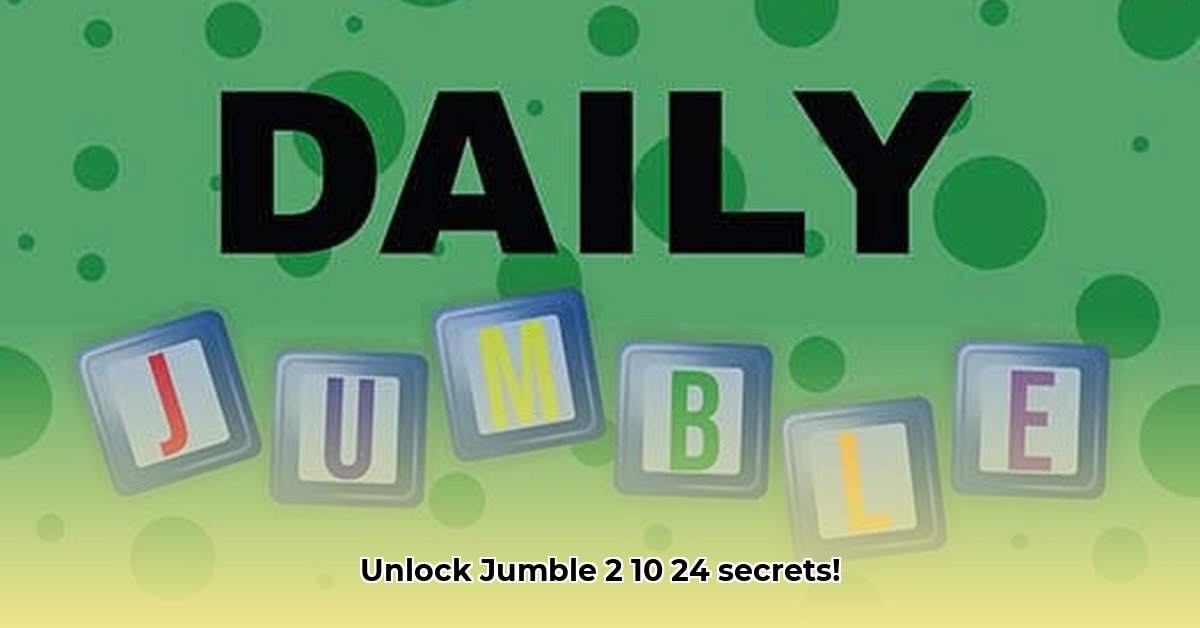
Ready to conquer the Daily Jumble? This guide provides expert strategies to help you solve those tricky scrambled words quickly and efficiently. Whether you're a beginner or a seasoned player, you'll find tips and techniques to improve your game and boost your puzzle-solving skills. For extra help, check out this helpful resource.
Crack the Code: Mastering Jumble Strategies
Forget relying on luck! Let's equip you with effective strategies for fast and accurate Jumble solutions. This isn't about memorization; it's about developing a systematic approach.
Analyze the Letters: Spotting the Clues
Begin by carefully examining the jumbled letters. What stands out? Unusual letters (like Q or Z) often indicate the start or end of a word. Keep an eye out for common letter combinations such as "ing," "ed," "th," or "sh"—these are your linguistic breadcrumbs! This initial scan creates a foundation for your solution. Did you notice any particularly frequent letters?
One Word at a Time: A Strategic Approach
Don't try to solve the entire puzzle at once. This is a guaranteed recipe for frustration. Instead, focus on one word at a time. Start with the shortest word; it's usually the easiest to decipher. Solving this first word builds confidence and provides valuable clues for the remaining words, creating a domino effect of success. What's the shortest word in your current Jumble?
Context is King: The Power of Inference
As you progress, you'll discover the importance of context. Think about how the words might relate to each other. Does the puzzle suggest a theme or connection? This often appears visually in the accompanying cartoon. The more Jumbles you solve, the better you'll become at recognizing patterns and intuitively piecing together the solutions. What theme do you think the cartoon for Jumble 2 10 24 might suggest?
Take a Break, Return Refreshed
Even the most experienced Jumble solvers hit a wall sometimes. If you're stuck, step away. A fresh perspective often unlocks the solution. Your brain continues processing information even when you’re not actively looking at the puzzle. Returning to it with a rested mind can lead to a sudden breakthrough. How long do you typically take a break for when facing a difficult Jumble?
Leverage Common Words: Your Secret Weapon
Many Jumble solutions utilize common words. If a letter combination looks familiar, ask yourself, "Is this part of a common word?" This dramatically reduces the possibilities you need to consider. Thinking about common words dramatically improves your speed and accuracy. How many common English words can you recall in a minute?
Strategies for Every Skill Level
The following table outlines approaches for various skill levels:
| Skill Level | Strategy | Example |
|---|---|---|
| Beginner | Focus on unusual letters and common letter groups. | A "Q" and "U" usually go together! Look for "ING" or "TH." |
| Intermediate | Combine letter analysis with contextual clues and word length. | The cartoon hints at a specific theme—use this to your advantage. |
| Advanced | Use intuition and pattern recognition to quickly eliminate unlikely combinations. | Your brain will often instinctively recognize the most probable words. |
Expert Insights on Conquering Daily Jumbles
Mastering the Daily Jumble relies on a combination of strategy and practice. Here are some additional expert-level strategies for tackling challenging puzzles.
Deciphering Jumbled Letters: A Systematic Approach
Begin by meticulously examining the jumbled letters. Look for common letter combinations and frequently occurring patterns within English words. This initial analysis acts as a crucial starting point for your solving process. Identifying the most common letter and its frequency is a key element to this analysis.
Harnessing Context Clues: Unlocking Hidden Meanings
The cartoon, often accompanying the puzzle, is not merely decorative; it's a vital clue. The cartoon’s narrative, characters, and visual elements directly relate to the final answer. Understanding the visual context helps to narrow down the pool of potential words, refining your accuracy and efficiency. Consider the emotions conveyed in the cartoon. Do they hint at specific words?
A Step-by-Step Approach to Solving Jumbles
Let's break down the process with a hypothetical example: Assume the jumbled words are LREATE, OPLUE, GNIIHG, and ROSA.
- Start Easy: Identify the simplest word. (e.g., ROSE)
- Prefixes/Suffixes: Look for common word beginnings or endings (e.g., "ING" in "GNIIHG").
- Common Combinations: Find frequently used letter pairings (e.g., "PL" in "OPLUE").
- Contextual Elimination: Use the cartoon's context to eliminate unlikely words.
- Experimentation: Try different letter arrangements until you find a logical solution.
- Verification: Ensure that all words fit seamlessly together.
Advanced Techniques: Level Up Your Game
For exceptionally challenging Jumbles, consider these resources:
- Online Resources (Use with Caution): While independent problem-solving is key, online resources can offer support if you truly hit a wall. But be careful—try to get only hints, not full solutions!
- Consistent Practice: Regular practice accelerates your pattern recognition and improves your vocabulary, leading to faster and more accurate solutions.
The Daily Jumble is more than a puzzle; it's a rewarding brain workout that boosts vocabulary, hones problem-solving skills, and provides a satisfying sense of accomplishment. Keep practicing, and you'll become a Jumble-solving master in no time!